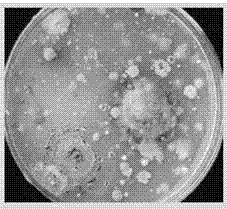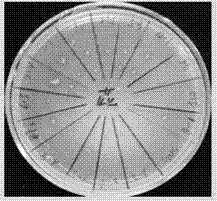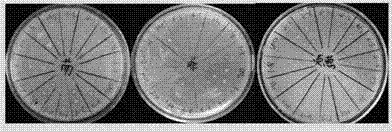Screening method for degradation bacteria with polycyclic aromatic hydrocarbon as substrate
A polycyclic aromatic hydrocarbon and screening method technology, applied in the field of contaminated soil bioremediation, can solve the problems of large workload, time-consuming and laborious, and high cost, and achieve the effects of saving time, shortening the ascending distance, and reducing waste
- Summary
- Abstract
- Description
- Claims
- Application Information
AI Technical Summary
Problems solved by technology
Method used
Image
Examples
Embodiment 1
[0026] 1) Collect the surface 0-20cm soil of the Shenfu irrigation area as a sample, and store it in a refrigerator at 4°C. Weigh 5g of the soil sample for testing and insert it into 45ml of liquid inorganic salt culture medium containing tetracyclic polycyclic aromatic hydrocarbon pyrene, wherein the concentration of pyrene is 100㎎ L -1 , add an appropriate amount of glass beads, and place on a constant temperature shaker at 28-32°C at 180 r·min -1 Enrichment culture for 1 month, after enrichment culture, pipette the first culture solution into 45ml liquid inorganic salt medium containing pyrene at a volume ratio of 10%, carry out second enrichment culture, repeat 4 times in total , every transfer, the concentration of pyrene increased by 100㎎·L -1 , that is, the last time the concentration of pyrene was increased to 400㎎·L -1 .
[0027] 2) Under sterile conditions, the enriched culture solution was serially diluted 10 times with sterile water to 10 -7 , take 10 respectiv...
Embodiment 2
[0040] 1) Collect the surface 0-20cm soil of the Shenfu irrigation area as a sample, and store it in a refrigerator at 4°C. Weigh 5g of the soil sample to be tested, and insert it into 45ml of liquid inorganic salt medium containing tricyclic polycyclic aromatic hydrocarbon phenanthrene (acenaphthene, fluorene, anthracene, fluoranthene, etc.), where the concentration of phenanthrene is 200㎎ L -1 , add an appropriate amount of glass beads, and place on a constant temperature shaker at 28-32°C for 180r·min -1 Enrichment culture for 1 month, after enrichment culture, pipette the first culture solution into 45ml liquid inorganic salt medium containing phenanthrene at a volume ratio of 10%, carry out second enrichment culture, repeat 4 times in total , each transfer, the concentration of phenanthrene increased by 100㎎·L -1 , that is, the last time the concentration of phenanthrene was increased to 500㎎·L -1 .
[0041] 2) Under sterile conditions, the enriched culture solution wa...
PUM
 Login to View More
Login to View More Abstract
Description
Claims
Application Information
 Login to View More
Login to View More - R&D
- Intellectual Property
- Life Sciences
- Materials
- Tech Scout
- Unparalleled Data Quality
- Higher Quality Content
- 60% Fewer Hallucinations
Browse by: Latest US Patents, China's latest patents, Technical Efficacy Thesaurus, Application Domain, Technology Topic, Popular Technical Reports.
© 2025 PatSnap. All rights reserved.Legal|Privacy policy|Modern Slavery Act Transparency Statement|Sitemap|About US| Contact US: help@patsnap.com



